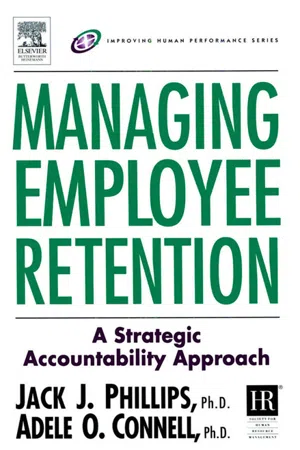Employee Costs
Employee costs refer to the expenses incurred by a company in relation to its employees. This includes salaries, wages, benefits, and payroll taxes. Understanding and managing employee costs is crucial for businesses to maintain financial stability and ensure profitability. Effective management of employee costs involves strategic planning, budgeting, and optimizing workforce productivity.
3 Key excerpts on "Employee Costs"
- eBook - ePub
- Jack J. Phillips, Adele O. Connell(Authors)
- 2004(Publication Date)
- Routledge(Publisher)
...Ten major cost categories are contained in the replacement costs. Recruiting/advertising. Expenditures directly related to attracting new employees are included. Image-building ads and materials, direct letters, and other communication tools are typical. Recruitment expenses. This category includes direct expenses involved in recruiting, such as travel to visit job candidates, conducting job fairs, and expenses to inform applicants about the organization prior to the actual application process. Recruitment fees and bonuses. One of the most significant expenditures for highly specialized employees and managers is the recruiting fees paid directly to third-party agencies. It is not uncommon for these fees to be equal to 1 year of the new employee’s salary or more. Employment bonuses. Bonuses may be paid for the employee to join the organization. Payments may include cash, expense allowances, vacation time, stock, stock options, or a new computer. Obviously, not all new employees enjoy such bonuses, but in more situations, specialized employees and managers are offered these items as incentive to join the organization. Selection interviews. This category includes the expenses associated with the interview process, including the interviewer’s time, materials, and other expenses directly related to the interview. Testing/pre-employment examinations. This item includes the cost of administering and analyzing any type of pre-employment test. Physical examinations, drug screening, and other pre-employment hurdles are included. Travel expenses. All company-reimbursed travel expenses for the candidates to interview for the job and cycle through the pre-employment process are included. This includes airfare, ground transportation, lodging, meals, and other direct expenses. Moving expenses. All moving expenses are included in this category, including fees for the relocation firm...
- eBook - ePub
Lean Implementation
Applications and Hidden Costs
- Frances Alston(Author)
- 2017(Publication Date)
- CRC Press(Publisher)
...6 Talent Management and Retention and the Hidden Costs 6.1 Introduction Developing and maintaining an environment where employees are satisfied and are actively participating in the business take planning and constant attention to changes in the work environment. All changes in the work environment have the potential to impact workers in various ways. Some changes may be welcoming and others may not be. These changes can serve to fuel an employee’s thought of looking for another place of employment. Talent retention can be a daunting problem for companies and can impact productivity, retention of key resources, and the financial bottom line. Replacing existing employees cannot always be quantified in dollars and cents because it involves two different types of costs often referred to as direct and indirect. Direct costs are easiest to calculate and can include the following: • Advertisements • Recruiting fees • Sign-on bonuses • Salary (a salary increase may be necessary to attract and retain qualified applicants) • Benefit costs Indirect costs can include the following: • Time invested in employee search and interviews • Loss of productivity • Reduction in product or service quality Indirect costs are generally difficult to quantify and is therefore often omitted as a cost element. For example, consider that trained employees will take their knowledge and skills with them when they leave the company. The organization will incur a loss of productivity or increase the potential for mistakes by new employees until they become fully trained to perform the work. Often, calculating these costs may not be considered or easily quantifiable. Therefore, when Lean impacts workers to the point that they believe it to be necessary to seek jobs elsewhere, a cost to the company has incurred. This is a classic time when talent management comes into play. A good talent management plan should be a part of the overall corporate strategic plan...
- eBook - ePub
- Lynne Milgram, M.D., MBA, Alan Spector, Ph.D., M.D., Matt Treger(Authors)
- 2010(Publication Date)
- Routledge(Publisher)
...200 Recognizing an Employee's Hidden Costs Many managers underestimate the cost of hiring a new employee. Before you hire a new employee, understand that the cost of doing so will far exceed the employee's hourly rate. In 1996, for example, the minimum wage was $4.75. Across the country, however, the average hourly cost per employee was $18.82 (U.S. Department of Labor, 1996). Table 8 lists payroll items you must consider before you hire an employee. Table 8 Factors Contributing to an Average $18.82 Per-Hour Cost of Compensation Factor 1996 Dollar Amount Percentage Total compensation $18.82 100.0% Wages and salary $13.48 71.6% Legally required benefits $1.59 8.5% Insurance $1.29 6.9% Paid leave $1.24 6.8% Retirement $0.75 4.0% Supplemental pay (overtime) $0.44 2.4% Other $0.13 0.6% In addition, within a business office, productive workers normally require a desk, chair, a phone and phone line, a computer, a printer, and other office equipment. Other costs include additional administrative costs (payroll processing, reviews, and personnel files), and training and startup costs. In order to budget correctly, a manager must take into account the hidden costs per employee....


